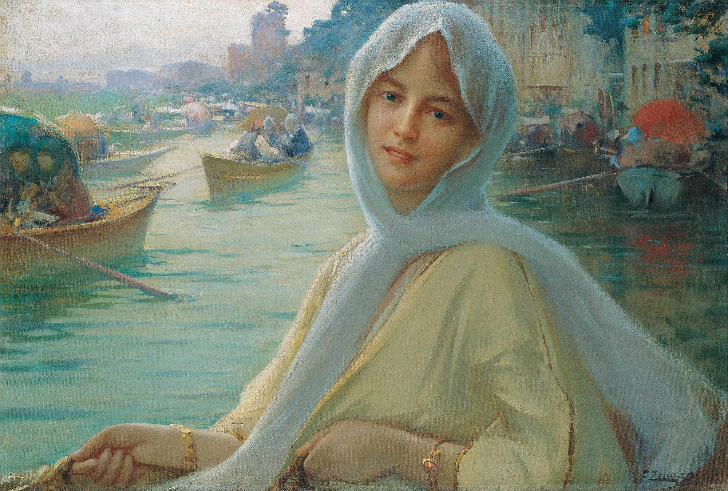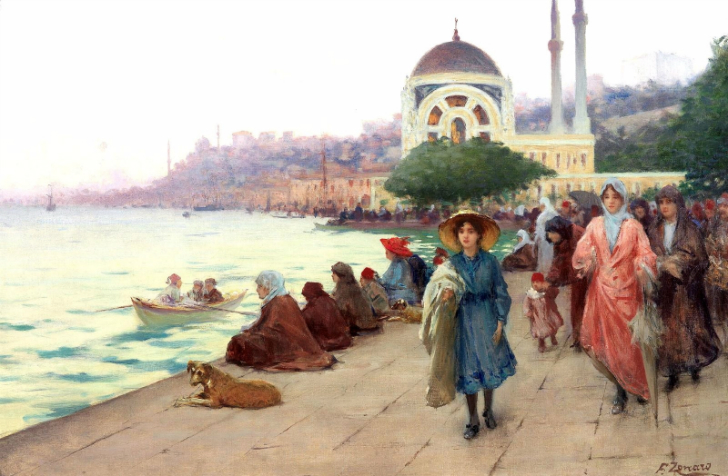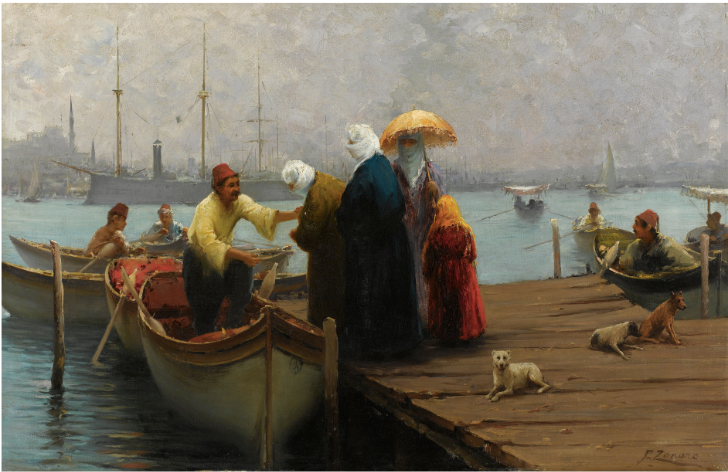He is known all over the world for his paintings about Istanbul: Who is Fausto Zonaro?
At a time when his hopes of proving himself as an artist in Europe are dashed, his wife, a very enterprising young woman, moves to Istanbul. Zonaro arrives in Istanbul 2 months after his wife, under extremely difficult conditions.

He was born in Padova in 1854. Fausto Zonaro started his professional life as an apprentice in construction. This is how he discovered his interest in painting.
“When I returned to my village, I immediately wanted to apply what I knew. I started to paint all the white walls of my house. When my work was noticed, I bought wall decoration works. So I earned my first money with my brush.”
He entered Accademia Cignaroli, one of the leading fine arts academies of those years. He completed his education, which he left unfinished due to his military service, at the Fine Arts Academy of Rome.
Fausto Zonaro (18 September 1854 – 19 July 1929) was an Italian painter, best known for his realist-style paintings of life and the history of the Ottoman Empire.
Fausto Zonaro travels to different cities in Italy. During these trips, he always tries to find an art environment and lifestyle where he can practice his art and be happy. He is always restless during these years. Meanwhile, he meets Elisa Pante, who wants to take painting lessons from him. Their relationship, which started with giving painting lessons to Elisa, progresses to the search for a better life and art environment together.
Istanbul has become a passion for Fausto Zonaro and his lover Elisa. At a time when his hopes of proving himself as an artist in Europe were dashed, Elisa, a very sociable young girl, acts before her soon-to-be husband Fausto Zonaro and moves to Istanbul. Two months after Elisa, Zonaro arrives in Istanbul under extremely difficult conditions. They settled in Pera. Zonaro describes his early days in his memoirs as follows.
“Elisa, my dear wife, I gained the strength to live in Istanbul because of you… When I think of the beginning years, we made a living by making watercolor paintings. We made frame repairs, photographed… But I will never forget Mr. Zellich and his sons, the owner of Zellich Bookstore in Yüksekkaldırım, who gave us the closest attention. We placed my paintings in its large showcase and valued each of them at 1 lira. Because my paintings were selling well, Mr. Zellich started taking orders on my behalf and immediately paid for the first four paintings sold. This was the first money I earned in Istanbul.”

To earn money, Zonaro paints small Istanbul paintings for tourists on the Galata Bridge, and Elisa paints her street photos with watercolors and prints them on silk, and sells them.
They got married in 1892 at St Esprit Church. Meanwhile, they get a new environment. One of them is Osman Hamdi Bey, they become friends.
While Zonaro was crossing the Galata Bridge on a Friday in 1896, he met the Ertuğrul Cavalry Regiment and was extremely impressed by the majesty of the regiment. He admires this view and the white horses on the bridge. He goes to the Galata Bridge every Friday and begins to watch the passing of the Ertuğrul Cavalry Regiment with insatiable excitement. He waits for the cavalry to pass, draws portrait studies, and uniform details as they approach, and transfers every detail to his sketches, down to the number of buttons.

After a while, he becomes such a familiar face that while he is working, the regimental commander and officers greet him and express their friendship with a smile. Zonaro paints the famous Ertuğrul Horseman on the Bridge. He presents this painting to the palace. Sultan Abdulhamit liked the painting very much and he gave it the title of Painter-i Hazrat Shahriyari, that is, the Palace Painter, together with 20 gold coins.
His close friend Münir Pasha liked the painting Ertuğrul Cavalry Regiment on the Bridge very much. But there is a problem. The barefoot boy and the gypsy in the picture don't like it. Zonaro explained:
“I am in the presence of the dearest friend Münir Pasha, the kindest and friendliest person in the palace… Look, His Excellency the Sultan does not like poverty at all and cannot imagine that there are people walking around barefoot. Isn't there a way to dress this boy up nicely?"
Zonaro does not accept such a change in his painting and the painting is given to the sultan. A lot of time passes. President of the French Parliament Paul Deschanel comes to visit him on the 25th anniversary of Abdülhamit's accession to the throne. When he likes the painting, Abdülhamit gives it to him.

In order to fill the empty place on the wall in the palace, Sultan Abdulhamid demands that the same painting be made again. After a while, Zonaro does the work Ertuğrul Cavalry Regiment on the Bridge again. However, with some changes… A barefoot boy and gypsies watching the procession in the first version of the painting are not present in this painting this time. It is replaced by well-dressed Istanbuls and Zonaro and his wife. Obviously, the warning given by Münir Pasha beforehand was effective.
Hacı Ahmet, the father of Enver Pasha, one of the commanders of the Movement Army, is wanted everywhere. Zonaro hides his friend Hacı Ahmet in his house. On April 26, 1909, the Army of the Action entered the city. The painter and Hacı Ahmet go to Enver Bey the next day.
Enver Bey both poses for the painter and tells that the Sultan will be dethroned in three days. Zonaro did not tell this secret to the sultan.

With the proclamation of the Second Constitutional Monarchy, Zonaro was dismissed from his duty as a palace painter after Abdulhamid was deposed. He was told that he could live in Akaretler 50 building, which he used as a house and workshop, only if he paid the rent. Disturbed by this attitude of the Unionists, Zonaro decided to return to Italy.
In 1910, he first put his paintings in 46 chests and sent them to the Port of Naples with a ship company, and then to Rome by transfer. Many of Zonaro's paintings, which had been waiting in the Port of Naples for 12 days, were damaged by bad weather. Zonaro returned to Italy with his wife on Orient Express. Fausto Zonaro, who died in San Remo in 1929, is known all over the world for his paintings about Istanbul.
